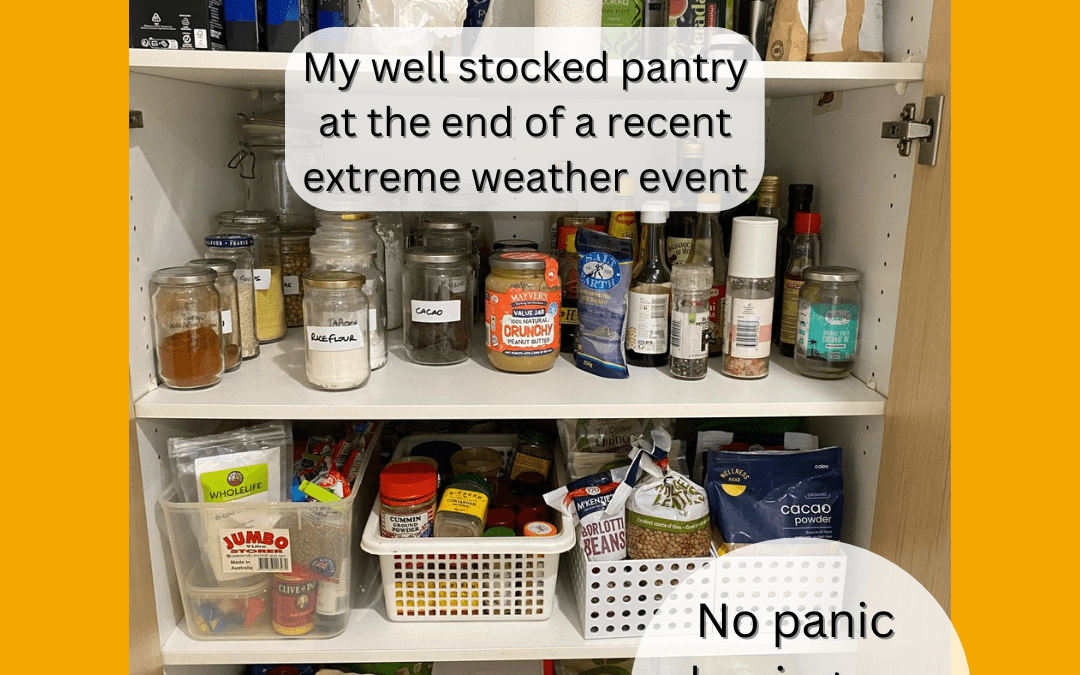Coming to the end of an extreme weather event in Cairns, I was happy to notice that our pantry was still fairly full of food Plus we had never run out of fruit and veggies the whole time.
During extreme weather and a lengthy low, we had experienced flooding. Living in Far North Queensland in Australia, it’s easy to get cut off and this had been the case. Food trucks hadn’t been able to get through and supermarket shelves had been empty or low for two weeks.
Post after post on social media showed people panicking. Photos of empty shelves, people opening their last can of beans. Individuals sharing which shops they had found food recently. And as soon as word went out those shops were cleared immediately by food hunters.
Granted it can get a bit scary. Perceiving a lack of food can trigger our survival response. Food is one of the important needs of the root chakra for safety. The problem is that this emotion is contagious and can influence some quite unresourceful behaviour. Think empty toilet paper shelves from the pandemic years.
Panic doesn’t help us have more food. In fact, it creates more scarcity
During my many years as single mum I learned how to provide good food for my family with a scarcity of money. We lived those years in Cooya Beach which is a very small community between Port Douglas and Mossman. Many people reading this article possibly wouldn’t have heard of those towns.
Cooya Beach had a community of just 250 people when we lived there. No public transport and no shops. At that time even Port Douglas only had a small convenience store for food. When we first moved to that area we used to come to Cairns to stock up once each month.
In addition, we were also frequented by cyclones during the warm months. So the possibility of being cut off, without food and even clean drinking water and power was high. During those years I learned how to prepare well in advance for extreme weather events, and on a very small budget.
And, because extreme weather is becoming more frequent again, I want to share those tips with you now. This will hopefully help you be pre prepared for next time. Just in case you’re hoping that was the last time, rest assured there will be a next.
But first let’s look at the three biggest mistakes people make during extreme weather events or when a cyclone is announced:
Mistake Number 1 – People panic shop for food and hoard
Once a weather event is announced, such as potential flooding or cyclone it’s not the time to leave the shops with an overflowing trolly or two. This creates more panic and food scarcity when we’re about to get cut off.
Preparing in advance means that you will never feel a need to do this. Plus it makes sure that there is always enough to feed the community even when nothing is getting through.
Mistake Number 2 – Creating a mountain out of a mole hill
I know this sounds easy to say and that’s because I am always prepared. We are not an island here in Cairns, even when we’ve been cut off. The region is a food producing area and there is plenty which is locally grown and produced. Creative thinking allows you to find food even when it’s not being transported from south. Think about all the local farmers in our area, do some research. Other local food suppliers like Rusty’s Markets, Johnsons and a number of others. Dried foods can be found at Source, Community Foods etc.
Even if you’re unable to find your usual fresh produce, it won’t kill you to live without them for a couple of weeks. There are plenty of other ways to consume the correct nutrients during that time.
Remember also, everything comes to an end and extreme weather doesn’t last forever. Try to reflect back on the positives and the small amount of time we were cut off during the last event.
Mistake Number 3 – People buy into the collective energy of lack
It’s real easy to buy into panic when we listen too much to media on TV, radio, the web and social media. Social media especially engages the senses with lots of visuals, videos and people sharing their fears, frustrations and lack. It can create a sense of helplessness.
The best way is to remind ourselves that everything will be okay. Turn off mainstream and social media. Put on our own thinking caps and get creative with the food we already have. Remember that if we’ve pre prepared well, then we will have plenty available to share.
When to begin pre preparing your food stocks
The biggest point I’d like to make here is that the announcement of a weather event or during is not the time to build our food stocks. As I said previously, this just creates panic and often wasted food that ends up in the garbage. If we’ve pre prepared well there is never a need to do this. At most we only need to dash to the shops to buy a handful of items.
Building food stocks begins months earlier than an extreme weather event. We have about six months each year where we’re not affected by floods or cyclones. This is the time to start preparing.
Stock piling food gradually doesn’t cost a lot of money upfront
When we gradually build our stock of food each week, fortnight, or month, depending on how often we do our shop, we hardly notice the cost. Here I’m talking about a packet of frozen veggies, extra tin of beans, tuna, salmon, extra bag of lentils, rice, quinoa.
These are non perishables and if it’s not the usual food you eat, then start to search recipes on Google, so you are prepared. With dried food too you will also need to search for soaking and cooking times to make these foods nutritionally available to your body. Tinned veggies also need to be rinsed prior to using if they have been preserved in salt water.
Non-perishables to stock pile during the dry season
Obviously organic is a much better option if you can get it, but if budget is an issue there are plenty of others around. Dried goods are a lot healthier and more budget conscious than the tinned version. You get a lot more for your dollar. Tinned is fine too though.
Dried Food
Bags dried lentils
Bags of dried beans and chickpeas
Bags of seeds such as chia, sesame, pumpkin, sunflower, flax, hemp
Bags of nuts such as almond, walnut, pecan, hazelnut, cashew
Bags of cereals and grains such as brown rice, rolled or steel cut oats, buckwheat, quinoa
Packets of pasta – look for those made from legumes because they are high in protein too
Bags of dried fruit such as dates, sultanas, raisins, figs, apricots, prunes
Packets of seaweed for example nori
Tinned Food
Tinned chickpeas
Tinned beans such as cannellini, red kidney, black beans, baked beans
Tinned fish such as tuna, salmon, sardines
Other tinned veggies including tinned tomatoes
Tinned coconut milk
Frozen Items
Packets of mixed veggies such as cauliflower, broccoli, beans, carrots
Packets of corn and peas
Packets of singular veggies such as carrots, peas etc
Packets of fruit such as blueberries, strawberries, raspberries
Vacuum Sealed Products
Variety of milks – soy, almond, oat, cow’s milk, coconut
And of course drinking water
There are a number of other non perishables we stock, I’m just giving you the basics here. As always when you’re choosing your stocks, remember to read labels and buy food that has no preservatives or additives. There are plenty around and once you know the labels and brands, it becomes easy to choose.
None of these foods are fresh and yet when combined will provide a variety of nutritional value. The weather event will not last forever and it will do no harm to live off these foods for a few weeks. But do your own research anyway.
However, there is another way to get fresh fruit and veggies even when there is none in the shops. This is one other thing we do at our place, that makes a huge difference. Not just during a weather event, but all year round.
Start growing your own food for sustainability
I say “we” here, but I’m not taking credit for this. My partner loves to garden and this is his baby. We began seeding and growing our own food during the pandemic and each year we reap the benefits. So do our family and friends when we have excess.
Does it take effort? Absolutely! It also takes a lot of research and learning how to prepare soil, protect the plants from excess sun and rain. Understanding which plants grow well in the tropics and which don’t.
This only requires a small area if that’s all you have. As you learn you adapt the way you grow and how your garden or courtyard is set out. Growing your own food in pots is also possible even if you live in an apartment and just have a balcony. Many of our plants are in pots even though we have garden beds.
Growing your own is definitely something worth considering. Especially if you want to make sure you have fresh food during extreme weather, pandemics or whatever else can interrupt our usual food supply.
Continue to support our local farmers and food suppliers
Please do remember that if you usually go to the big chain supermarkets, but have been blessed to find food elsewhere during an event, continue to support them. Without our local farmers and local food suppliers, we’d definitely be up sh…..t creek. They need our support all year round, not just when supermarket shelves are empty.
This creates sustainability in our neck of the woods. With more support these amazing people can maintain a steady food supply for us all year round, no matter what.
And of course, when you do stock pile food in advance regularly check your pantry. Make sure they are consumed before use by dates and replenish them as needed. That way nothing ever goes to waste.
More details and background about the author HERE

